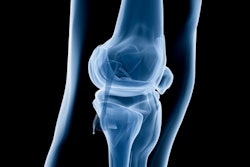A pair of studies presented at this month's RSNA 2011 meeting adds to the growing body of evidence underscoring the negative impact of physician self-referral. Duke University researchers found that orthopedic physicians who have a financial interest in MRI equipment order more studies and also have higher rates of negative exams.
Radiologists Dr. Ramsey Kilani and Dr. Matthew Lungren investigated whether ownership of MRI equipment by nonradiologist physicians would predict the likelihood and/or distribution of positive findings on knee and lumbar spine MRIs. The two teams also sought to evaluate knee and lumbar spine MRI pathology rates as a metric of similarity between two patient groups compared in the study.
The findings support the notion that efforts to reduce the costs of medical imaging should be targeted at situations that result in unnecessary utilization, as opposed to across-the-board cuts in imaging reimbursement, according to the researchers.
To knee or not to knee
The group began by noting the relationship between self-referral and overall imaging utilization.
"Self-referral parallels very well the growth of medical imaging spending," Kilani told RSNA session attendees. "In fact, in 2006, 64% of Medicare Part B imaging spending went to physician offices, and 68% of that went to nonradiologists, while 32% went to radiologists. Nonradiology offices are doing over twice as much imaging as radiology offices."
The study included 989 consecutive knee MRI scans acquired over a six-month period by two orthopedic groups that serve the same geographic community: one group with a financial interest in MRI equipment (516 scans), and one without (473 scans). All studies were performed with identical protocols and were interpreted by one musculoskeletal radiology group with no financial interest in imaging equipment, Kilani said.
"A lot of self-referrers will say that their patients are different, their practices are different, where they live is different, [and that these factors explain the imaging utilization increase]," Kilani said.
To be included in the study, a patient had to be having an MRI for the first time, and had to have no prior surgery or other intervention. Findings were considered positive if the following injuries were present:
- Anterior cruciate ligament (ACL)
- Posterior cruciate ligament (PCL)
- Medial collateral ligament (MCL)
- Lateral collateral ligament (LCL)
- Meniscal tear
- Full thickness cartilage defect or bone lesion
- Patellofemoral extensor mechanism
For both groups, Kilani's team calculated the mean patient age, the percentage of negative examinations, the distribution of lesion count per positive scan, and the relative frequency of each specific lesion among the positive studies.
Among the 989 scans included in the study, 310 were negative (187, or 19%, of the total in the financially incentivized group; 123, or 12%, in the group without financial incentive). The number of negative scans in the incentivized group was 52% higher than in the group without financial ties, even though the patient groups were age-matched and from the same geographic community, and the orthopedic practices had similar demographics, the researchers noted.
"I want to emphasize that [the higher use rate for knee MRI] could be a subconscious thing; I'm not implying that it's sinister [on the part of these physicians]," he said. "But it is clear that if you own a scanner, you use it more."
Among the scans that were positive for pathology, there was no statistically significant difference in the average total number of positive lesions per scan -- 1.44 for the financial incentive group and 1.57 for the nonfinancial incentive group -- or in the frequency of six out of the seven positive lesion types, which suggests highly similar distribution and severity of disease between the two patient samples, Kilani said.
The researchers also analyzed the ordering practices of the two groups, and found that they were quite similar.
"Over half of the physicians in each of these orthopedic groups trained at same academic center," he said. "Mean years in practice was 14 between each group, and the vast majority had subspecialty training."
Similar findings with lumbar spine MRI
In the second study, Lungren and colleagues used data from the same practices in Kilani et al's study. The lumbar spine MRI scans were interpreted by the same subspecialty musculoskeletal radiology practice, which had no financial interest in imaging equipment. Final reports were reviewed and considered positive if they showed moderate or severe spinal canal stenosis, moderate or severe neuroforaminal narrowing, moderate or severe facet degenerative disease, disk protrusion contacting a nerve root, or osseous abnormalities.
Among the 500 lumbar spine MRI scans that Lungren's team reviewed (250 in the financially incentivized group and 250 in the nonfinancially incentivized group), 163 were negative, with 106 negative scans (42%) in the financially incentivized group and 57 (23%) in the group without financial ties.
The number of negative MRI scans for incentivized physicians was even higher, at 86%, in this study than in the knee MRI study. Among the positive scans, there was no statistically significant difference in the average total number of positive lesions per scan, with 3.93 lesions per scan in the financially incentivized group and 4.31 in the nonfinancially incentivized group.
"Lumbar spine MRIs referred by physicians with a financial interest in the imaging equipment used were significantly more likely to be negative than those referred by physicians with no financial incentive," Lungren concluded.
A new way to assess overuse?
The kind of studies that Kilani and Lungren conducted could be an exciting way to investigate larger sets of data to establish methods to analyze appropriate utilization patterns for advanced imaging, according to Kilani.
"Across-the-board cuts threaten to limit access to imaging," Kilani told AuntMinnie.com. "A more intelligent approach [to managing healthcare costs] is to eliminate the obvious conflict of interest and identify [imaging] studies more likely to be unnecessary."



.fFmgij6Hin.png?auto=compress%2Cformat&fit=crop&h=100&q=70&w=100)





.fFmgij6Hin.png?auto=compress%2Cformat&fit=crop&h=167&q=70&w=250)











